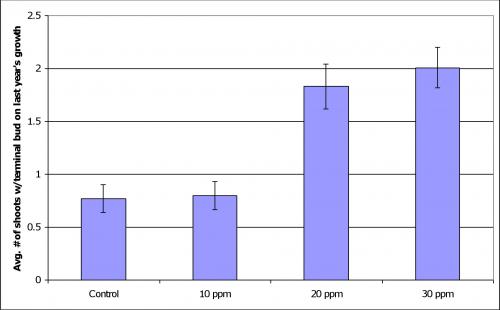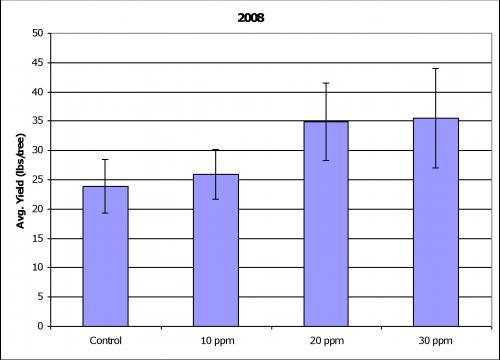Gibberellic acid applications in cherries
To help manage crop load in cherries, growers should be applying Pro-Gibb to cherries when five to seven leaves are expanded.
Gibberellic acid (GA) is a plant hormone that promotes growth and elongation of cells. In tart and sweet cherries, GA has been used successfully to reduce flowering during the early years of an orchard's life. The reduced flowering and subsequent reduced fruiting helps young trees increase vegetative growth. In addition, minimizing flowering in early years slows the transmission of pollen-borne viruses in young trees. Michigan State University Extension has also shown that GA used in mature tart cherry orchards can increase fruiting capacity by stimulating the formation of lateral shoots and spurs.
When GA is applied to cherry trees in late spring, a percentage of the flower buds forming for the following season will be converted to vegetative buds. Therefore, GA application in 2014 influences flowering in 2015. The effectiveness of GA is dependent on rate, timing and temperature. Surfactants have also been shown to influence GA applications. As a rule of thumb, high GA rates are required to prevent young trees from fruiting, whereas much lower rates are used to keep bearing trees in a good balance between vegetative and fruit production. GA applications should be made when daily high temperatures are expected to be above 70 degrees Fahrenheit for two to three days, if possible. We have observed poor results when applications are made when daily high temperatures are below 60 F as is the case with most growth regulators.
Non-bearing trees
GA is typically applied to non-bearing cherries with a hand gun, so rates are applied on a dilute basis. The best results are generally achieved with two applications of 50 ppm – 20 fluid ounces of 4 percemt formulated product per 100 gallons of water. The first application should occur three to three and a half weeks after full bloom, followed by a second application two and a half to three weeks later. An alternative method, though slightly less effective, is to apply a single treatment of 100 ppm – 40 fluid ounces per 100 – at about three to four weeks after bloom.
GA should not be applied to trees during the year of planting due to possible phytotoxicity. Vigorously growing trees in their second leaf do not need GA as these trees naturally produce little fruit the following year. GA application often starts in year three, but may be desirable in year two if trees start off poorly. These high rates should continue until the year prior to first harvest or year of production.
Early bearing trees
To bring young cherries into bearing following GA treatments with high rates, growers should phase down GA rates rather than discontinuing GA use all at once. A sudden drop of GA from high rates to nothing will result in oversetting of fruit and potential tree stunting. Trees that have been kept vegetative with GA use have a tremendous capacity to set (overset) fruit.
The year prior to when growers first desire fruiting, they should apply GA at 30 to 40 ppm if spraying dilute (12-16 fluid ounces per 100 gallons) or 20-24 fluid ounces per acre if applied at a concentrated rate. This rate per acre for concentrate spraying takes average tree size into account; therefore, growers should not reduce the rate further based on tree row volume. The next year, decrease this rate to 15 to 20 ppm applied dilute (6-8 fluid ounces per 100 gallons) or 10-12 fluid ounces per acre concentrate. The following year, 10 ppm is optional, but often not required. In orchards where growth is weak, growers should continue annual GA applications at 10-15 ppm as described for bearing trees.
Bearing trees
Growers should apply GA three to four weeks after bloom or when trees have five to seven leaves, three to five fully expanded, on terminal growth. GA should be used at rates of 10 to 20 ppm or 4 to 8 ounces per 100 gallons of ProGibb 4 percent or equivalent when applied dilute. For concentrate application to full-sized tart cherries, use 6 ounces per acre of product to achieve a 10 ppm response or 12 ounces per acre for a 20 ppm response. Lower rates are typically used on more vigorous orchards or those with previous successful use of GA. Adding surfactants has caused varied responses – everything from increased phytotoxicity to no GA-related effects. Therefore, adding a surfactant is not suggested unless a grower has enough experience with a product to have confidence in the response.
GA use on Balaton
Balaton appears to have less need for GA during non-bearing years to maintain good tree growth, but as it matures, the variety produces a lot of blind wood. Therefore, using GA is strongly encouraged on bearing Balaton trees. Fig. 1 shows the successful use of GA to increase lateral shoots and spurs in a Balaton orchard at the Northwest Michigan Horticulture Research Station (NWMHRS). However, we cannot conclude that GA applications improve Balaton yields although GA does appear to increase crop load (Fig. 2).
Figure 1. Average number of shoots with terminal buds in a Balaton orchard.

Figure 2. Average Balaton yield with different rates of GA.

Dr. Rothwell's work is funded in part by MSU's AgBioResearch.



 Print
Print Email
Email


